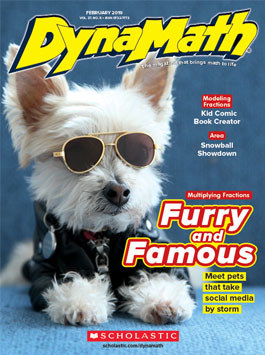Recently I had a great conversation with Angela Schelton, a 4th grade public school teacher and DynaMath subscriber in Santa Fe, New Mexico. We talked a lot about math warm-ups, and how she uses them in her classroom. Here are some of the field-tested strategies for incorporating math warm-ups into your lessons:

5 Math Warm-Ups That Take 5 Minutes
More math moments make a world of difference
Begin your math lessons with a 5-minute math problem to motivate students.
1. One problem, five minutes to complete
Schelton begins her math lessons by projecting a problem on her smart board. Then she gives students 5 to 10 minutes to do the problem in small groups. They work through the answer themselves. Then they discuss together.
Often, Schelton uses a question from our Problem of the Day skills sheet. If you’re not already familiar with this resource, here’s what you need to know: Each month we publish 20 math questions in our Teacher’s Guide. (Additionally, if you search “problem of the day” online, you can download current and past skills sheets from our archive. And don’t forget the online answer key for answers!)
2. Using warm ups as cumulative review
Education gurus—like Steve Leinwand, an analyst at the American Institutes of Research and former math teacher—encourage daily cumulative review at the beginning of each lesson to help students achieve math mastery.
It’s one of the most effective strategies for fostering the retention of critical skills, he said in his presentation at NCSM last spring.
During warm up or cumulative review time, you can also ask students what they notice and wonder about a question or math concept. If you do this already you are probably pleasantly surprised with the results!
3. Have students present their work
Post a math problem at the beginning of class. Have students solve it individually. Then assign a student or small group leader to show their answer and problem-solving method to the whole class.
4. Find errors as a class
Present problems where students find the mistake in solving or determine which one doesn't belong. It’s a great way to introduce critical thinking and high order learning. Plus students love proving to their teacher that they’re right!
5. Make math a movement activity
Students spend a majority of their day sitting. You can easily incorporate movements into your math lessons as a quick 5-minute warm-up or review.
Have students create acute and obtuse angles with their arms or play Stand Up/Sit Down with multiples. If the multiple is 6, and you call out 36, students have to stand up. If it’s not a multiple, like 35, they stay seated.
Do you have a 5-minute warm-up to start math class that your students love? If so, we want to hear about it. Send us an email!
Want more elementary math education tips and news? Check out Scholastic's archive.
Alexa Kurzius (@ackurzius) is the Senior Associate Editor of DynaMath, one of Scholastic’s elementary STEM magazines.
Recent Posts
-
July 7, 2021
SEL in the Math Classroom: Strategies for Resilience
-
January 30, 2019
Make the Most of DynaMath–With Google Classroom!
-
January 8, 2019
Easy Classroom Updates for 2020
-
December 3, 2019
4 Fun Ways to Use Math Around the Holidays
-
September 10, 2019
Fun Math Icebreaker Activity
Exciting ideas and fun teaching strategies for using DynaMath in 3rd, 4th, and 5th grade math classrooms


